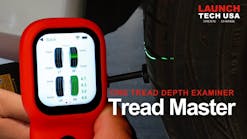TechTip #8: Diagnosing P0420/P0430 DTCs – Initial Checks
It starts by understanding how a converter can fail.
· Overheated, melted or broken substrate in the converter
Catalytic converters work most efficiently when the feed gasses its being sent are kept within a very narrow lambda range.
That’s the primary job of the ECM!
And if those feed gasses wander outside of that range, for any reason and even just a little bit, the converter can overheat and suffer damage.
· Converter poisoning
Converter poisoning means that the substrate has been coated by a foreign substance and is no longer exposed to the exhaust stream.
Excessive oil consumption and coolant leaks past the intake or head gaskets are common contaminates, as is the improper use of certain sealants.
· Structural damage
Structural damage can be physical damage like dents caused by road debris striking the housing, stripped oxygen sensor threads, thermal shock to the converter and metal fatigue at mounting points or welds.
So the first step is a visual inspection of the entire exhaust system. In addition to looking for physical damage, you’ll also want to test the system for leakage, especially around the oxygen sensor bungs, converter welds, and any flexible tubing used. Air leaks here can affect how the sensors read and lead to improper fueling commands from the ECM – throwing off the feed gasses and overheating the cat.
One way you can check for leaks is to use your shop vacuum to pressurize the exhaust. Simply swap where the vacuum hose connects and attach the end to the tailpipe, sealing it with duct tape. Turn the vacuum on and use a soapy water mixture to look for bubbles!
If no physical damage is apparent, then I like to use a thermal IR gun to check the operating temperature of the converter. The conversion process produces heat. So, exhaust gases entering the converter should be cooler than the gases exiting the converter.
If conversion is taking place, then the outlet bushing reading should be higher than the inlet bushing reading. However, different pipe wall thicknesses and corrosion, along with different heat transfer rates may cause inaccurate results. Only use this test to prove that a catalyst is good.
Make sure that the engine is fully warmed up and running. Measure the temperature of the pipe just ahead of the converter inlet at the weld ring. The weld ring is the point where the inlet pipe is welded to the converter body. Depending on their size, most converters begin to function, or “light off” around 350°F and are fully lit around 500°F. If this temperature is never reached, the converter may be faulty or is not receiving the right feed gas mixture from the engine.
Next, measure the temperature of the outlet weld ring. Calculate the difference between your readings.
The converter's rear weld ring temperature is directly related to the amount of work the converter is performing. Under normal conditions, the rear weld ring may reach temperatures as much as 150°F higher than the front weld ring. If the outlet reading is higher than the inlet reading, you can be assured that at least some conversion is taking place. On well-tuned, newer vehicles, the catalyst can be fully functional at only a 20°F difference so only use this test to confirm a good converter and not to condemn one as failed.
Typically, converter temperatures will not exceed 1200°F on a properly running engine. Periodic operation above 1600°F can negatively affect the precious metals coating on the substrate, reducing its efficiency.
A bronze/blue rainbow discoloration of the shell typically indicates elevated temperatures. Excessive temperatures can reduce the converter's durability, or, if high enough, destroy the converter's matting or substrate. Damaged matting and melted substrates typically occur at temperatures exceeding 1700°F. It is possible to test for a cracked substrate or damaged matting by tapping on the converter housing. Using a rubber mallet, "thump" the shell, listening for loose components. Restrictions in the converter resulting from broken or melted substrate can also be seen on your thermal imager as cold spots displayed within the converter’s shell.
Performing a visual inspection by using a borescope may provide clues to poisoning but are not conclusive when it comes to melting or internal restrictions. If the DTCs are accompanied by customer complaints of low power or sluggishness, perform a Volumetric Efficiency test and review fuel trims for evidence of a restriction in the system.
But if these initial checks point to a cat that’s working just fine, focus your troubleshooting on the inputs used by the ECM in setting the code. Odds are pretty good that someone’s lying! And don't forget to check TSBs - you'll be surprised at how many P0420/P0430 DTCs are fixed by a reflash!
Interested in the Snap-on Thermal Laser? https://shop.snapon.com/product/Diagnostic-Thermal-Tools/Diagnostic-Thermal-Laser/EETH311
See the entire line of Snap-on Diagnostic tools at: https://shop.snapon.com/categories/700040



